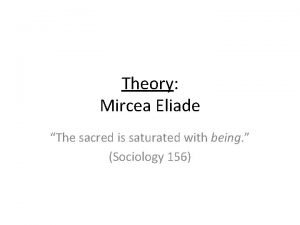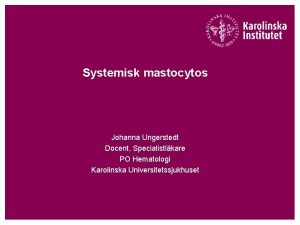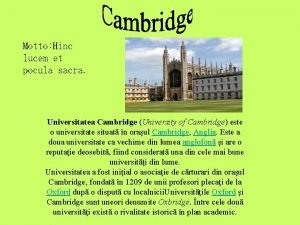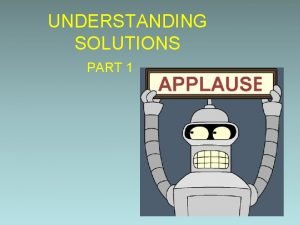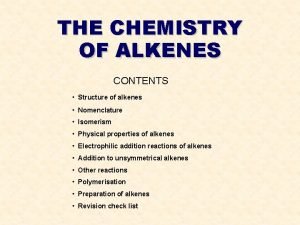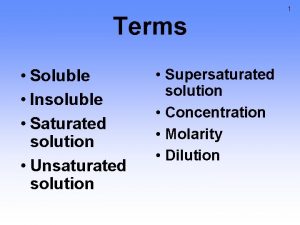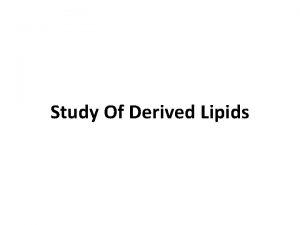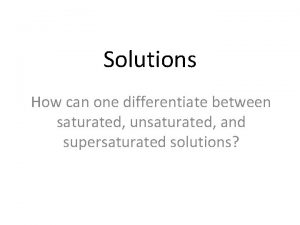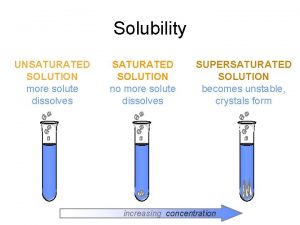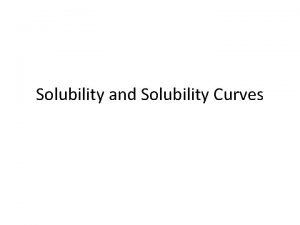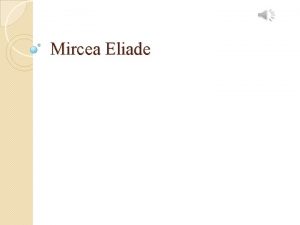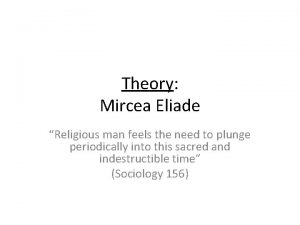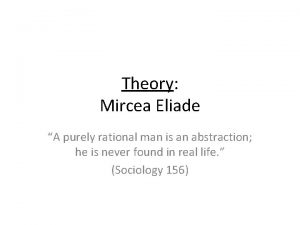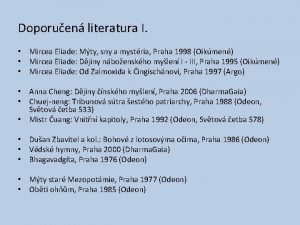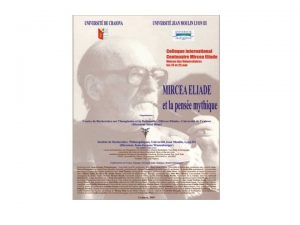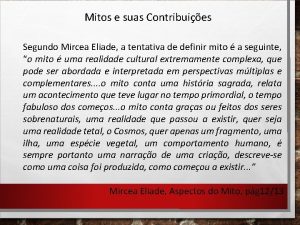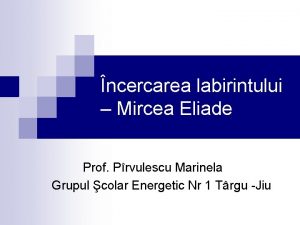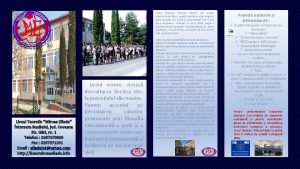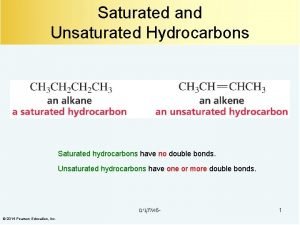Theory Mircea Eliade The sacred is saturated with




















- Slides: 20

Theory: Mircea Eliade “The sacred is saturated with being. ” (Sociology 156)

Mircea Eliade • 1907 -1986 • Novelist, philosopher, scholar • The Iron Guard – Romanian fascist, anti. Semitic organization • University of Chicago, UC Santa Barbara • The Sacred and The Profane, The Myth of the Eternal Return 2

Method • Comparative – In search of commonalities across religious traditions – The more comparisons available, the better • Essentialist – Each religion, and religion itself, has a distinct essential character or quality that makes it what it is • Ahistorical – Understanding the essence is of greater importance for Eliade than is understanding its historical development 3

Sacred and Profane • “We propose to present the phenomenon of the sacred in all its complexity, and not only so far as it is irrational. What will concern us is not the relation between the rational and the nonrational elements of religion but the sacred in its entirety. The first possible definition of the sacred is that it is the opposite of the profane. ” (10) – Hierophany: “the act of manifestation of the sacred” (11) • “The manifestation of something of a wholly different order, a reality that does not belong to our world, in objects that are an integral part of our natural, ‘profane’ world. ” (11) • Could be a tree, a vision, an incarnation (11) • A paradox: “A sacred stone remains a stone. . But for those to whom the stone reveals itself as sacred, its immediate reality is transmuted into a supernatural reality. ” (12) 4

Sacred and Profane • “The sacred is equivalent to a power, and in the last analysis, to reality. The sacred is saturated with being. Sacred power means reality and at the same time enduringness and efficacity. The polarity sacred-profane is often expressed as an opposition between real and unreal or pseudoreal. ” – “Thus, it is easy to understand that religious man deeply desires to be, to participate in reality, to be saturated with power. ” (12) 5

Sacred and Profane • The project: “To show in what ways religious man attempts to remain as long as possible in a sacred universe, and hence what his total experience of life proves to be in comparison with the experience of the man without religious feeling, of the man who lives, or wishes to live, in a desacralized world. ” – The fully desacralized world is “a recent discovery in the history of the human spirit. ” (12) • “Sacred and profane are two modes of being in the world, two existential situations assumed by man in the course of history. ” (14) – A broad, sweeping study intended to show commonalities between different forms of the sacred (16) 6

Sacred Space • “For religious man, space is not homogenous; he experiences interruptions, breaks in it; some parts of space are qualitatively different from others. ” • “‘Draw not nigh hither, ’ says the Lord to Moses; ‘Put off thy shoes from off thy feet, for the place whereupon thou standest is holy ground. ’” (Exodus 3: 5) – “This spatial nonhomogeneity finds expression in the experience between space that is sacred—the only real and real-ly existing space—and all other space, the formless expanse surrounding it. ” (20) 7

Boundaries Between Sacred & Profane Space • Example: a church in a modern city • “For a believer, the church shares in a different space from the street in which it stands. The door that opens on the interior of the church actually signifies a solution of continuity. The threshold that separates the two spaces also indicates the distance between two modes of being, the profane and the religious. – “The threshold is the limit, the boundary, the frontier that distinguishes and opposes two worlds” while also being the point at which they communicate (25) • Gates of heaven, threshold rituals at houses 8

9

Sacred Space • At the place of a hierophany, “there is not only a break in the homogeneity of space; there is also revelation of an absolute reality, opposed to the nonreality of the vast surrounding expanse. The manifestation of the sacred ontologically founds the world. ” (21) – Not only demarcates space, but allows for a fixed point of the ‘real’, by which orientation can be established from this fixed point, or center of the world • The point of hierophany ‘founds’ the world (22) • Makes a ‘world’ out of space – “For profane experience, on the contrary, space is homogenous and neutral. ” (22) • Yet even here, there are ‘traces’ of sacred space: hometown, place where a person fell in love, high school, etc. (24) 10

Constructing the World • Recall: “Religious man’s desire to live in the sacred is in fact equivalent to his desire to take up abode in objective reality, not to let himself be paralyzed by the never-ceasing relativity of subjective experiences, to live in a real and effective world, and not in an illusion. ” (28) – Thus, methods of orientation are “techniques for the consruction of sacred space. ” – A ritual for constructing sacred space “is efficacious in the measure in which it reproduces the work of the gods. ” (29) • Cosmogony 11

Constructing the World • The ‘world’ or cosmos is inhabited, constructed, organized. (29) • The unknown & uninhabited (by us) world “still shares in the fluid and larval modality of chaos. By occupying it and, above all, by settling in it, man symbolically transforms into a cosmos through a ritual repetition of the cosmogony. ” (31) – Raising a pillar symbolizing the world tree, axis mundi, or sacred mountain – Conquistadores raising crosses, which is “equivalent to consecrating the country, hence in some sort to a ‘new birth. ’” (32) – “Discovery” of North America, “exploration” of Africa 12

Outside the World • “Since ‘our world’ is a cosmos, any attack from without threatens to turn it into chaos. And as ‘our world’ was founded by imitating the paradigmatic work of the gods, the cosmogony, so the enemies who attack it are assimilated to the enemies of the gods, the demons, and especially the archdemon, the primordial dragon conquered by the gods at the beginning of time. (47 -48) – “An attack on ‘our world’ is equivalent to an act of revenge by the mythical dragon, who rebels against the work of the gods, the cosmos, and struggles to annihilate it. ” (48) – Tiamat, Jörmungandr, Lucifer • In Medieval Europe, “the walls of cities were ritually consecrated as a defense against the devil, sickness and death[, . . . ] assimilating the human enemy to the devil and death. ” (49) – “The Free World”, “World War” 13

Axis Mundi • The center of the world, the reference point – Often conceived as the “highest point” • Palestine: “not submerged by the flood” • Kaaba: “the Pole Star bears witness that it faces the center of heaven” • Golgotha: the summit the cosmic mountain (38) • Jerusalem in The Divine Comedy • “All these beliefs express the same feeling, which is profoundly religious: ‘our world’ is holy ground because it is the place nearest to heaven, because from here, from our abode, it is possible to reach heaven; hence our world is a high place. ” (39) 14

Constructing the World • “The religious man sought to live as near as possible to the Center of the World. . But he wanted his own house to be at the Center and to be an imago mundi. ” – “The man of traditional societies could only live in a space opening upward, where the break in plane was symbolically assured and hence communication with the other world, the transcendental, was ritually possible. ” (43) – Had access at the temple or sanctuary, but wanted to be always in the presence of the sacred, so if the cosmos is “a vast tent supported by a single pillar” then so will be the home (53) – A dwelling as sacred space, rather than “a machine to live in” (50) • “Every construction or fabrication has the cosmogony as paradigmatic model. ” (45) – Ordering the world = Creating the world 15

Constructing the World • But sometimes the cosmogony was an act of sacrifice or violence. In these cases, these same acts will accompany construction. – A serpent’s head to represent the slaying of Tiamat (55) – European ballads describing “the sacrifice of the wife of the master mason so that the structure may be completed” (56) • Old practices survive as folklore – “London Bridge is Falling Down” (? ) • “Habituations are not easily changed, for it is not easy to abandon one’s world. The house is not an object, a ‘machine to live in; it is the universe that man constructs for himself by imitating the paradigmatic creation of the gods, the cosmogony. ” (56 -57) 16

The Temple • “If the temple constitutes an imago mundi, this is because the world, as the work of the gods, is sacred. But the cosmological structure of the temple gives room for a new religious valorization” – “As house of the gods, hence holy place above all others, the temple continually resanctifies the world, because it at once represents and contains it. ” – Due to this ontological difference between the cosmos and its sanctified image, “the sanctity of the temple is proof against all earthly corruption. ” (59) • The plan for the Tabernacle given by God, eternal rather than created 17

18

• Via hierophany, “the world becomes apprehensible as world, as cosmos, in the measure in which it reveals itself as a sacred world. ” – “Religious man can live only in a sacred world, because it is only in such a world that he participates in being, that he has a real existence. This religious need expresses an unquenchable ontological thirst. Religious man thirsts for being. His terror of the chaos that surrounds his inhabited world corresponds to his terror of nothingness. ” (64) – For him, “every existential decision to situate himself in space in fact constitutes a religious decision, ” because the center of the world is “the very source of absolute reality. ” (65) 19

• “Religious man’s profound nostalgia is to inhabit a ‘divine world, ’ is his desire that his house shall be like the house of the gods, as it was later represented in temples and sanctuaries. ” – “In short, this religious nostalgia expresses the desire to live in a pure and holy cosmos, as it was in the beginning, when it came fresh from the Creator’s hands. ” (65) 20
 Mircea eliade galati
Mircea eliade galati Nuvele de mircea eliade
Nuvele de mircea eliade Heroicsearch.com
Heroicsearch.com Imago mundi eliade
Imago mundi eliade Inscriptia de la mircea voda
Inscriptia de la mircea voda Johanna ungerstedt
Johanna ungerstedt Rezumat florin scrie un roman
Rezumat florin scrie un roman Liceul tehnologic mircea vulcănescu
Liceul tehnologic mircea vulcănescu Universitatea din cambridge
Universitatea din cambridge Saturated adiabatic lapse rate
Saturated adiabatic lapse rate Tuesday please
Tuesday please Suspension example
Suspension example Saturated fat examples
Saturated fat examples Bromine test for unsaturation
Bromine test for unsaturation Oxalic acid is saturated or unsaturated
Oxalic acid is saturated or unsaturated Unsaturated fat chain
Unsaturated fat chain Types of solution
Types of solution Difference between saturated and unsaturated solution
Difference between saturated and unsaturated solution Quizlet
Quizlet Saturated unsaturated and supersaturated
Saturated unsaturated and supersaturated A supersaturated solution
A supersaturated solution



